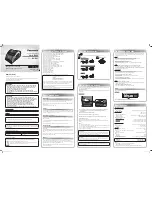
Glossary
Page x
CM System Users Manual
CCITT — International Telegraph and Telephone Consultative Committee.
C/I — Carrier-to-Interference Ratio.
CLK — Clock.
Codec — Coder/Decoder.
Co-located — located in the same rack, as in two CM radios.
Constellation — The totality of possible signal states used by the modem to send level information. Each point comprising
the pattern is described by I and Q coordinates.
CTIA — Cellular Telecommunications Industry Association.
D
D — D word time or pattern; D frame.
D/A or DAC — Digital-to-Analog Converter.
DADE — Differential Absolute Delay Equalization.
dBm0 — dB above reference noise measured with C-message weighting at 0 transmission level point.
DEC — Double Error Correction.
DEMOD — Demodulator (plug-in module).
DFM — Dispersive Fade Margin, a measure (in dB) of a system's immunity to dispersive fade activity.
DISGAP — Distributed GAP.
Dispersive Fade — A change in propagation condition which affects the shape of the desired channel response. Typically, this
is caused by multipath activity and is equalized by the ATDE and Slope Equalizer.
DIU — Drop and Insert Unit (plug-in module).
DIV — Diversity.
DRO — Dielectric Resonator Oscillator.
DS1 — Digital Signal 1, the primary multiplex level in North American TDM hierarchy (1.544 Mbps).
DS3 — Digital Signal 3, the third multiplex level in North American TDM hierarchy (44.736 Mbps).
DSB — Double Side Band.
DSB-SC — Double Side Band-Suppressed Carrier.
DTMF — Dual Tone Multi-frequency.
DVM — Digital Voltmeter.
E
E1— Primary multiplex level in International TDM hierarchy (2.048 Mbps).
E3— Third multiplex level in International TDM hierarchy (34.368 Mbps).
EFS — Error Free Seconds.
EMC — Electromagnetic Compatibility.
Summary of Contents for CM7
Page 2: ......
Page 4: ...Page iv 5 04 05 CM7 8 100Base T System User s Manual ...
Page 16: ...Glossary Page xvi CM System Users Manual X Y Z ...
Page 24: ...Microwave Networks CM7 8 100Base T System User s Manual Pagexxiv ...
Page 62: ...Chapter 2 Operation Page 2 18 5 02 05 CM 100Base T System User s Manual ...
Page 64: ...Chapter 3 Module Descriptions Page 3 2 CM7 8 100Base T ...
Page 88: ...Section 3 3 Transmitter Unit Page 3 3 6 CM7 8 System User s Manual ...
Page 96: ...Section 3 5 RF Power Supply Unit Page 3 5 4 CM System User s Manual ...
Page 100: ...Section 3 6 SP Power Supply Unit Page 3 6 4 CM System User s Manual ...
Page 106: ...Section 3 7 Alarm and Control Unit Page 3 7 6 11 18 03 CM 100Base T System User s Manual ...
Page 124: ...Section 3 11 SYNDES Page 3 11 6 CM System User s Manual ...
Page 130: ...Section 3 12 SCU Page 3 12 6 11 18 03 CM 100Base T System User s Manual ...
Page 138: ...Section 3 13 OWU Page 3 13 8 CM System User s Manual ...
Page 150: ...Section 3 15 NMU Page 3 15 6 CM System User s Manual ...
Page 192: ...Chapter 5 Verification Page 5 20 CM System User s Manual ...
Page 194: ...Chapter 6 Maintenance Page 6 2 7 23 03 CM 100Base T System User s Manual ...
Page 224: ...Chapter 6 Maintenance Page 6 32 7 23 03 CM 100Base T System User s Manual ...
Page 226: ...Site Engineering Page 2 CM System User s Manual ...
Page 230: ...Appendix A T I Curves Page A 4 CM7 8 100Base T System User s Manual ...
Page 267: ...Microwave Networks CM System User s Manual PageB 37 ...
Page 268: ...Appendix B QuikLink Page B 38 CM System User s Manual ...
Page 282: ...Appendix D Alarm Codes Page D 6 5 02 05 CM 100Base T System User s Manual ...
Page 290: ...Appendix E Setting Frequency Page E 8 CM7 8 System User s Manual ...
Page 312: ...CM7 8 100Base T System User s Manual Page I 4 Microwave Networks ...











































